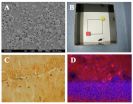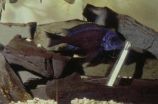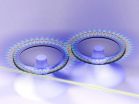(Press-News.org) Boulder, CO, USA — Ryan McKellar's research sounds like it was plucked from Jurassic Park: he studies pieces of amber found buried with dinosaur skeletons. But rather than re-creating dinosaurs, McKellar uses the tiny pieces of fossilized tree resin to study the world in which the now-extinct behemoths lived.
New techniques for investigating very tiny pieces of fragile amber buried in dinosaur bonebeds could close the gaps in knowledge about the ecology of the dinosaurs, said McKellar, who is a research scientist at the Royal Saskatchewan Museum in Saskatchewan, Canada.
"Basically it puts a backdrop to these dinosaur digs, it tells us a bit about the habitat," said McKellar. The amber can show what kinds of plants were abundant, and what the atmosphere was like at the time the amber was formed, he explained. Scientists can then put together details regarding what kind of habitat the dinosaur lived in and how the bonebed formed.
The preliminary findings about dinosaur ecology, habitat, and other results from four different fossil deposits from the Late Cretaceous in Alberta and Saskatchewan, Canada, will be presented on Monday, October 20 at the Geological Society of America Annual Meeting in Vancouver, Canada.
"Just a few of these little pieces among the bones can show a lot of information," McKellar said.
The type of amber that the scientists work with is not like the jewelry grade variety that can be made into a necklace or earrings.
"This type of amber hasn't been pursued in the past. It is like working with a shattered candy cane," he said. It is called friable amber, which is crumbly and fragile.
McKellar and his colleagues work with very small pieces of amber, just millimeters wide. But even samples at such a small scale can hold enormous clues to the past.
Before it hardened into amber, the sticky tree resin would often collect animal and plant material, like leaves and feathers. Scientists call these contents "inclusions," which they study along with the surrounding amber, to look at environmental conditions, surrounding water sources, temperature, and even oxygen levels in the ancient environment.
Insects can also be included in the amber, which can be even more helpful to scientists. One example is the discovery of an aphid, stuck directly to a duck-billed dinosaur with some amber. With a find like this, scientists can track insect evolution, find their modern relatives, and see how they might have interacted with dinosaurs, said McKellar.
"When you get insects, it is like frosting on the cake—you can really round out the view of the ecosystem."
Improvements in processing friable amber have made this research possible. Instead of the past technique of screening amber in a glycerin bath, the scientists reduce crumbling by vacuum-injecting the amber with epoxy, said McKellar.
Friable amber is widespread across the North American Continent in association with coals, and in the uncovered bonebeds, which means this area of research has expanded with the new techniques. It means scientists can sample at a finer scale, and still close some gaps in the past, especially regarding insect evolution, said McKellar.
Some of the early results of this method will be presented from amber pieces found with the skeleton of 'Scotty' the Tyrannosaurus rex, in Saskatchewan, Canada. McKellar will also be including case studies from three other bonebeds: the Danek Bonebed near Edmonton, Alberta; Dinosaur Provincial Park, Alberta; and the Pipestone Creek Pachyrhinosaurus Bonebed near Grande Prairie, Alberta.
INFORMATION:
Contact: Christa Stratton
+1-778-331-7625 during the meeting, 19-22 Oct. 2014
+1-303-357-1093 after the meeting
cstratton@geosociety.org
WHAT:
AMBER ASSOCIATED WITH LATE CRETACEOUS DINOSAUR BONEBEDS IN WESTERN CANADA
Abstract: https://gsa.confex.com/gsa/2014AM/webprogram/Paper249774.html Session No. 109
T212. Co-Evolution on Earth's Surface: Terrestrial Ecosystem and Environmental Interactions I
WHO:
Ryan C. McKellar, Royal Saskatchewan Museum, Regina, SK, Canada
WHEN & WHERE:
Monday, 20 October 2014, 11:15 AM
Vancouver Convention Centre-West 219
Photos available at http://www.geosociety.org/news/pr/2014/14-74.htm#photos
The Geological Society of America, founded in 1888, is a scientific society with more than 26,500 members from academia, government, and industry in more than 100 countries. Through its meetings, publications, and programs, GSA enhances the professional growth of its members and promotes the geosciences in the service of humankind. Headquartered in Boulder, Colorado, GSA encourages cooperative research among earth, life, planetary, and social scientists, fosters public dialogue on geoscience issues, and supports all levels of earth science education.
New Rochelle, NY, October 20, 2014—When it comes to picking an egg donor, until recent years, recipients tended to prefer someone with a similar appearance. Donor trait choices are changing, though, and which traits are now more preferable and why is the focus of "Beauty, Brains or Health: Trends in Ovum Recipient Preferences," an article published in Journal of Women's Health, a peer-reviewed publication from Mary Ann Liebert, Inc., publishers. The article is available free on the Journal of Women's Health website at http://online.liebertpub.com/doi/full/10.1089/jwh.2014.4792 ...
Boulder, CO, USA — Venus is hiding something beneath its brilliant shroud of clouds: a first order mystery about the planet that researchers may be a little closer to solving because of a new re-analysis of twenty-year-old spacecraft data.
Venus's surface can't be seen from orbit in visible light because of the planet's hot, dense, cloudy atmosphere. Instead, radar has been used by spacecraft to penetrate the clouds and map out the surface – both by reflecting radar off the surface to measure elevation and by looking at the radio emissions of the hot surface. ...
This news release is available in Spanish.
Enara Herran, a researcher at the UPV/EHU's Department of Pharmacy and Pharmaceutical Technology, is working to improve the way Alzheimer's and Parkinson's treatments are administered. And it is a fact that, as Herran herself stressed, "both diseases are becoming more and more common in our society".
Both disorders affect the neurones: their structure and function is lost, and this in turn leads to the deterioration in the patient's motor, cognitive, sensory and emotional functions. As Herran pointed out, in many cases ...
VIDEO:
The Internet "sleeps " -- but not everywhere. Find out why.
Click here for more information.
Researchers studying how big the Internet is have found that it "sleeps," almost like a living creature.
The finding will help scientists and policymakers develop better systems to measure and track Internet outages, such as those that struck the New York area after Hurricane Sandy. Understanding how the Internet sleeps will help them avoid confusing a sleeping Internet with ...
Fish just want to have fun, according to a University of Tennessee, Knoxville, study that finds even fish "play."
The research is published in the academic journal Ethology and can be viewed at http://bit.ly/1tLunpC.
Gordon Burghardt, a professor in the departments of Psychology and Ecology are Evolutionary Biology, is known for defining "play" in a way that allows us to identify it in species not previously thought capable of play, such as wasps, reptiles and invertebrates.
"Play is repeated behavior that is incompletely functional in the context or at the age ...
This news release is available in German. Diatoms play an important role in water quality and in the global climate. They generate about one fourth of the oxygen in the Earth's atmosphere and perform around one-quarter of the global CO2 assimilation, i.e. they convert carbon dioxide into organic substances. Their light receptors are a crucial factor in this process. Researchers at the Leipzig University and the Helmholtz Centre for Environmental Research have now discovered that blue and red light sensing photoreceptors control the carbon flow in these algae. These ...
WASHINGTON, DC – A mass of marine debris discovered in a giant sinkhole in the Hawaiian islands provides evidence that at least one mammoth tsunami, larger than any in Hawaii's recorded history, has struck the islands, and that a similar disaster could happen again, new research finds. Scientists are reporting that a wall of water up to nine meters (30 feet) high surged onto Hawaiian shores about 500 years ago. A 9.0-magnitude earthquake off the coast of the Aleutian Islands triggered the mighty wave, which left behind up to nine shipping containers worth of ocean ...
Since World War II, more than 45 international human-rights treaties have been signed by many of the world's roughly 200 countries. But why do some states sign such accords, especially if they lack a strong human-rights commitment in the first place?
One prominent idea holds that treaty-ratifying countries are essentially bought off: They agree to lend support to the human-rights movement in exchange for material good, such as foreign aid or more trade. However, a new study co-authored by an MIT political scientist finds that not to be the case; the actions of states, ...
This news release is available in German. What started out as a mathematical oddity, has now become a new kind of laser technology. Two years ago, physicists at TU Wien predicted a paradoxical laser effect: Under certain conditions, a laser can be switched on not by supplying it with more energy, but by taking energy away from the laser. First experimental signatures of this effect were recently reported at TU Wien. In collaboration with colleagues at Washington University in St. Louis, USA and at Riken, Japan the researchers have now succeeded in transferring the paradoxical ...
Amsterdam, NL, October 20, 2014 – White Canes provide low-tech assistance to the visually impaired, but some blind people object to their use because they are cumbersome, fail to detect elevated obstacles, or require long training periods to master. Electronic travel aids (ETAs) have the potential to improve navigation for the blind, but early versions had disadvantages that limited widespread adoption. A new ETA, the "EyeCane," developed by a team of researchers at The Hebrew University of Jerusalem, expands the world of its users, allowing them to better estimate ...






